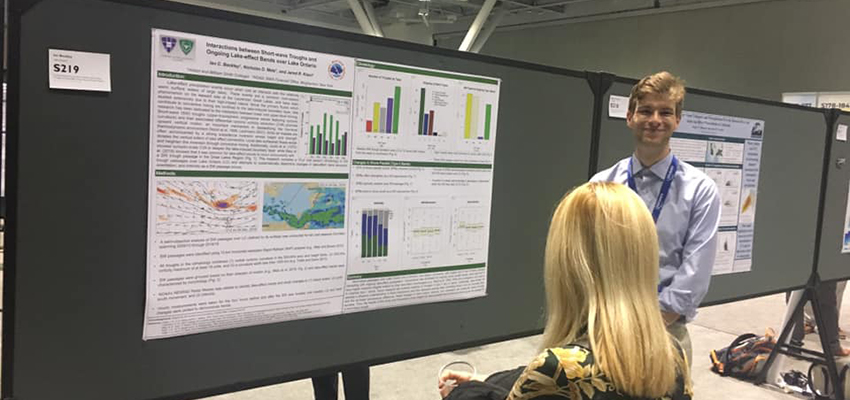
HWS News
24 March 2020 Beckley '20 Wins AMS Award and Selects Grad School
At the American Meteorological Society’s annual conference, Ian Beckley ’20 received an award for the presentation of his research investigating the interaction of short-wave troughs and lake-effect snow events off the coast of Lake Ontario. One of more than 200 undergraduates presenting, Beckley’s research was one of the few participants who received the honor of “Outstanding Student Conference Poster Award: Undergraduate.” He was recognized in the category of “Synoptic Meteorology.” In the fall, Beckley will attend the University of Wisconsin-Madison as a masters candidate in atmospheric science.
Beckley began his research on short-wave troughs and lake-effect snow in the summer of 2019 alongside co-authors Associate Professor of Geoscience Nicholas Metz and Jared Klein, the Science and Operations Officer at the National Weather Service Forecast Office in Binghamton, N.Y. Beckley has continued to pursue the topic through an independent study and a paid research position funded by a grant obtained by Metz and Klein from the University Corporation for Atmospheric Research.
“Lake-effect snow typically has really high snowfall rates but very low spatial coverages, which makes it a very difficult forecast,” says Beckley, a geoscience major and mathematics minor, and a member of the HWS sailing team.
When forecasters predict where lake-effect snow will fall and how much snow to expect, they use a variety of techniques. Through collaboration with the National Weather Service, Beckley learned forecasters typically look at variables in the lower atmosphere where cloud formations develop as cold air flows over a warm lake.

Beckley presents his research at the American Meteorological Society Conference.
“Our idea was to examine lake-effect snowbands when one of these short-trough waves moves over in order to determine how the band structure and evolution changes.”
As part of Beckley’s research, he created a 10-year climatology of these interactions. Of the total 666 short-wave troughs that crossed Lake Ontario, 255 crossed concurrent to an ongoing lake-effect band. He also determined that the short-parallel bands tend to increase in intensity, inland extent and move southward as a short-wave trough approaches. These bands tend to decrease in intensity after the trough passes. Beckley’s findings have led him to recommend that forecasters consider these upper-level interactions during lake-effect snow events.
Metz highlights the importance of the collaboration between the National Weather Service and academia. “There has been a long and important history of collaboration between various National Weather Services offices and academic institutions. This work carries on this tradition with a collaboration between HWS and the Binghamton office. In this way, the research results identified by Ian are seamlessly able to transition into the operational forecasting world and hopefully lead to better forecasts.”
Beckley has presented his work at the University of Albany at a Research Experience for Undergraduates poster session, at the Northeast Regional Operational Workshop in Albany, and the Northeastern Storm Conference in Saratoga Springs.
